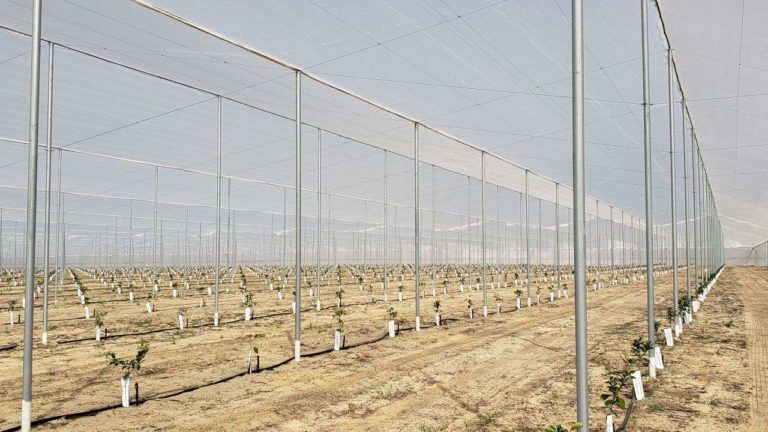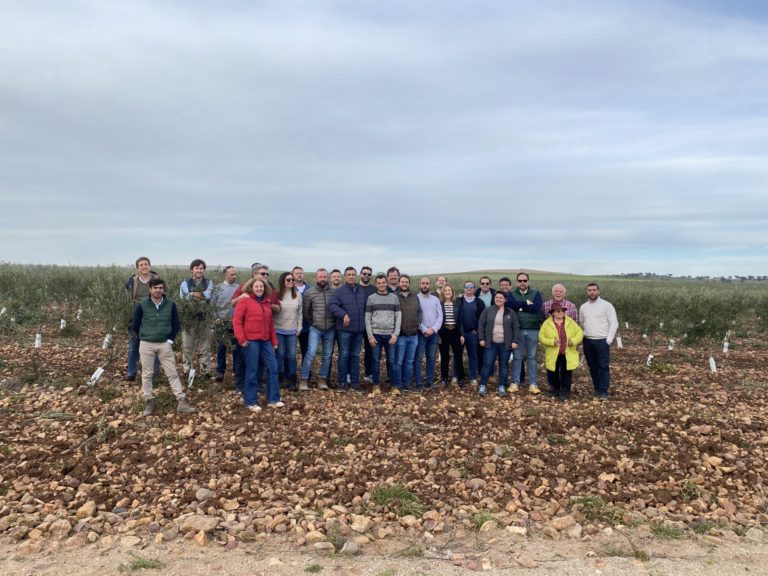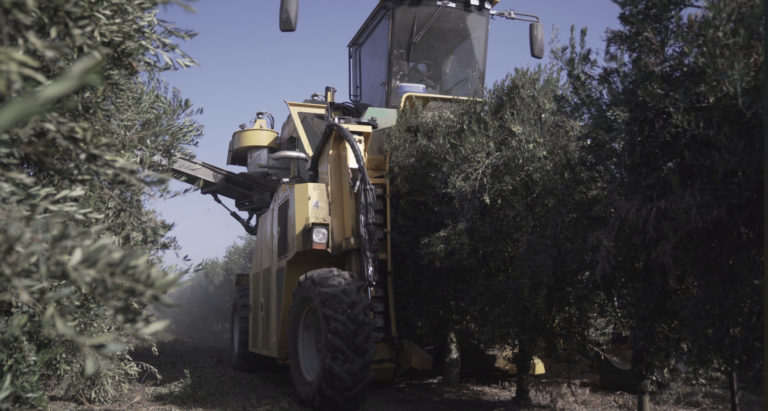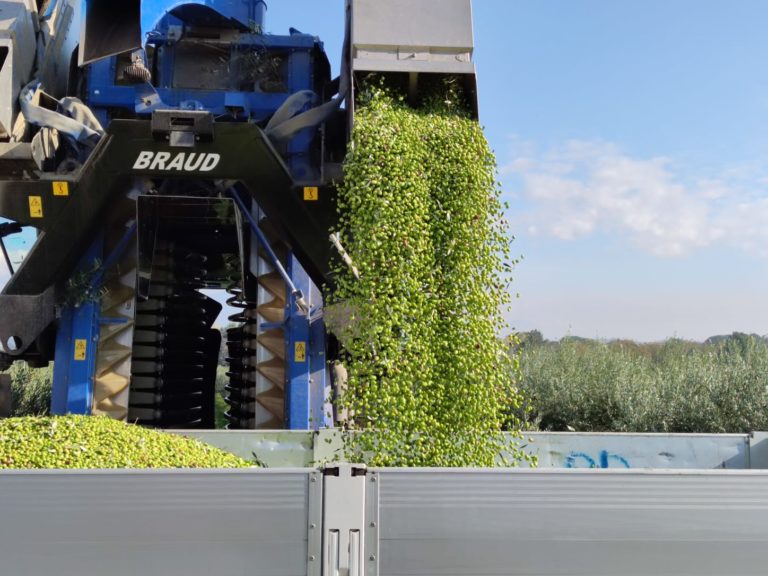Mantenimiento y monitorización de los sistemas de riego
Las comprobaciones regulares de los sistemas de riego (presión y caudal), indicarán si el sistema está operando de manera eficiente según las especificaciones de diseño. También puede ayudar a identificar problemas existentes en el sistema, antes de que el crecimiento y la producción del olivar se vean afectados.
Irrigation systems need to be checked at each irrigation unit regularly (every 2 years) or more frequently depending on water quality. Measuring pressures and flows will prevent trees from receiving unequal amounts of water and experiencing irregular growth.
Pressure reduction due to the accumulation of silt or oxides in sprinkler pipes, dirt in filters, etc., can cause variations in the supplied flow. A pressure loss of 35 kPa can represent a 15% reduction in flow (depending on the sprinkler model, nozzle size, and working pressure).
Pressure reduction in irrigation systems leads to a decrease in the sprinkler’s coverage radius. The center of the distribution triangle, created by the sprinklers, will not receive enough water, resulting in reduced growth and increased susceptibility to salinity.
La filtración en los sistemas de riego
Even with a good filtration system, blockages can be frequent, so filters, main pipes, and lateral pipes should be cleaned regularly.
Thorough and periodic cleaning of the entire irrigation system will maximize irrigation efficiency. The level of dirt in the water exiting the pipes indicates the frequency of necessary cleaning.
In drip systems, chlorination of the installation to reduce organic matter blockages and the use of acids (phosphoric) to clean calcium and iron impurities are recommended.
Evaluation of the Irrigation System
- Obtaining information regarding the irrigation system:
- Plans and maps of the irrigation system, plantation, soil map,
- topographic map, drainage pipes.
- Manufacturer data of system components (pumps, filters, emitters, etc.).
- topographic map, drainage pipes.
1 sino se dispone será necesario excavar para determinar el diámetro de las tuberías.
Evaluation of the Irrigation System:
a. Repair obvious system problems (damaged pipes, stuck valves, blockages in pipes or emitters, clogged filters, losses in pump connections, etc.).
b. Clean all pipes.
c. Carry out pump checks by authorized personnel.
d. Check filter cleanliness using gauges on both sides of the filter.
e. Check the main pipe’s efficiency for different irrigation units by comparing calculated pressure loss with measured pressure. If excessive pressure reduction is observed, the cause should be located.
f. Operate the irrigation system and check valve pressures for each unit, check 2 emitters in a minimum of 8 positions. Emitters in the highest, lowest, and middle zones should be checked. Acceptable pressure variations are ±10% for sprinklers and ±7.5% for drippers.
g. When checking pressures, flow rates should be measured. The measurement method depends on the irrigation system.
h. With flow rates, calculate the distribution uniformity (DU). Results should be less than ±5%.
i. Calculate the application index.
Calculation of Pressure Variation
Figura 1.1.- Esquema de diseño de una instalación de riego
Calculate the average pressure: (values in kPa)
Sprinkler 1: 150 Sprinkler 2: 155 Sprinkler 3: 150
Sprinkler 4: 160 Sprinkler 5: 170 Sprinkler 6: 160
Sprinkler 7: 145 Sprinkler 8: 155 Sprinkler 9: 145
Add all pressures and divide by the number of sprinklers:
154 kPa average pressure
Calculation of the midpoint pressure: Add the maximum and minimum pressure and divide by 2. 170 + 145 = 315 / 2 = 157,5 kPa
Calculation of pressure variation: Obtain the difference between the minimum pressure and the midpoint. Divide the difference by the midpoint and multiply by 100 to get the percentage. 157,5 – 145 = 12,5 (12,5 / 157,5) * 100 = ±7,9%
The pressure variation is less than ±10% so it is acceptable. For drippers, it should be less than ±7.5%.
Variations above 10% indicate that the system is poorly designed, lacks pressure regulators, or they are misadjusted or there are blockages.
Calculation of Flow Variation (Values in liters/minute)
Sprinkler 1: 30 Sprinkler 2: 32 Sprinkler 3: 31
Sprinkler 4: 31 Sprinkler 5: 40 Sprinkler 6: 24
Sprinkler 7: 36 Sprinkler 8: 35 Sprinkler 9: 39
Perform the same calculations as for pressure.
Flow variation: ±25%
The flow variation is greater than ±5% so it is NOT acceptable.
Calculation of Distribution Uniformity in the Irrigation System
The uniformity of sprinkler coverage is measured by placing a series of identical containers arranged in a grid between the sprinklers (for example: 2 meters apart in the row and 4 meters between rows, place the containers in the middle of the row to avoid interference with vegetation). The sprinklers are activated for a known period of time (e.g., 4 hours). Ensure that the volume of the containers is greater than the theoretical amount of water to be supplied. After irrigation, record the volume of water collected in each container.
Record:
The spacing between plants, sprinklers, and containers.
The type and model of sprinkler and nozzle diameter.
Working pressure.
Wind direction and intensity.
Volume of water collected in each container.
Calculation Process:
Calculate the average volume of all containers = a
Calculate the average volume of the lowest 25% of values = b
Distribution uniformity; DU% = (b / a) x 100
The DU value should be at least 85%.
Figura 1.2. Prueba de campo para el cálculo de la uniformidad de distribución de un sistema de aspersores. (S) Aspersor (O) Recipientes
Availability of software programs with manufacturer data (models, nozzle types, working pressures) for different types of emitters is very helpful for effective irrigation system design.
Distribution Uniformity for Drippers
Follow the same calculation process as with sprinklers.
Ensure that the container collects all water from the drip (if necessary, tie it to the drip pipe).
Calculation of Application Index
It is a measure that indicates the millimeters of water applied per hour.
Sprinklers:
Application ratio = Average flow rate (l/h) of sprinklers
Distance between sprinklers (m) * distance between rows of sprinklers (m)
Drippers:
Application ratio = Average flow rate (l/h) of drippers
Distance between drippers (m) * distance between rows of drippers (m)
Application ratio = Number of drippers per ha * average flow rate (l/h) of drippers
10.000 m2
Irrigation system with a flow meter:
Application ratio = Volume (kl)
Pumping time (h) * Irrigated area (ha) * 10
Measurement of Flow and Pressures
Sprinklers: Pressure: Use a Pitot tube connected to the pressure gauge.
Flow: Insert a hose into the sprinkler nozzle, calculate the time required to fill a known volume.
Figura 1.3. Manómetro para
la medición de presiones
Drippers: Pressure: Insert a special dripper with a nozzle for the pressure gauge..
Flow: Place containers under the dripper to collect water and measure the time required to fill a known volume.
Foto 1. Sistema de riego por goteo. Instalación de un gotero fijo exterior (color azul)
con conexión a manómetro para el control de presiones
Micro-sprinkler: Pressure: Thread a T between the sprinkler and the support to connect a pressure gauge.
Flow: Place the sprinkler in a container and calculate the time required to fill a known volume.
If you liked this post, visit our blog for more. https://www.agromillora.com/olint




